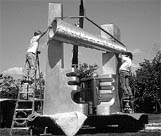
|
Sculpture Thoughts Reviews Bibliography Biography Video Contact Us |
|
|
|
 Two Face Telescope, 1990 Fabricated aluminum Three elements: Approx. 14 x 12 x 6 feet |
|
 The juxtaposition of the paintings and prints of Toko Shinoda and the sculpture of Elizabeth de Cuevas reveals both artists' profound engagement with their respective cultural and aesthetic heritages, their concern with traditional imagery or techniques transformed in the context of modernism, and their sensitivity to materials and meticulous craftsmanship. With her smaller pieces, de Cuevas initially works out her conception in wax while the larger pieces are conceived in plaster. These unwieldy and delicate plasters are reinforced with elaborate armatures, intricate metal cages designed especially for the artist by Toto Meylan. De Cuevas is clearly fascinated with the technical aspects of her sculpture and is involved in each stage of the casting of her works as well as the application of a rich and lustrous patina. De Cuevas is particularly challenged by the problems involved in the translation of Running Heads to a monumental form. The precise angle of the series of heads—essential to the impression of momentum and fluidity which characterizes this work, defies gravity and demands an imaginative approach to the basic issues of weight and balance. The same meticulous attention to detail is evident in the precision and elegance of the joints and pins of the moving parts in Triptych Head, or the devices from which the profiles are suspended in the series of five monumental Heads. The interplay of dark and light, solid and void, the lustrous metal forms which do not merely outline or encompass but rather enliven space, invites comparison with the balance of black ink and luminous background in Shinoda's works. In particular, de Cuevas' juxtaposition of highly polished steel and the dark, even velvety surface of the bronze, complements very elegantly the interplay of light and dark, shiny and matte in Shinoda's compositions. The dominant images of de Cuevas' work are the human head or profile, the mouth and eye. The dramatic exploration of solid and void, as well as the reductive, abstract rendering of facial elements clearly reveals the impact of Archipenko and Lipchitz, masters of modern sculpture. However, though her basic subject is the human head or visage, de Cuevas' works do not call for discussion in the context of traditional portraiture. Rather, these are abstracted faces, masks, totems or ritual objects, which elicit association with the religious and cultural contexts of ancient Greece, Egypt, Central America or the Far East. The eye, by far the dominant motif in de Cuevas' oeuvre, is a psychologically powerful image, communicating simultaneously an outwardly turned cosmic vision and a serene introspective gaze. This image reflects, moreover, the artist's Jungian fascination with myths and religions of many different cultures and times. De Cuevas' small bronzes are conceived as maquettes for large scale, architectural sculptures. In fact, this marriage of the human form and monumental scale, evokes quite explicit associations with Pharaonic sculpture or the monumental Buddha's of the East. Obelisk Head, the seven foot tall work on display at the entrance of the Museum, conveys the potential of the small bronzes to be translated into large scale, public pieces. De Cuevas' aspirations to the architectural or monumental do not diminish the immediate impact of the small bronzes which present mysterious, miniaturized environments, reminiscent of the tabletop works of Giacometti or the unsettling Surrealist spaces in de Chirico's paintings. This exhibition brings together, then, two contemporary artists who combine in their works a profound fascination with aesthetic and cultural traditions and a refined manipulation of modern forms. In Toko Shinoda's works there is a balance between the discipline of ancient Japanese calligraphy and the spontaneity of twentieth century gestural abstraction. The ancient clearly inspires Elizabeth de Cuevas' imagery and techniques, as well, yet her works address essential issues of modern sculpture. Originally published in its entirety in the exhibition catalogue, Ancient Visions through Modern Eyes, Works by Elizabeth de Cuevas and Toko Shinoda, The Bruce Museum, Greenwich, Connecticut, 1984. |
|
|
||
|
|
Copyright © 2000 Strong-Cuevas. All rights reserved.
|
|